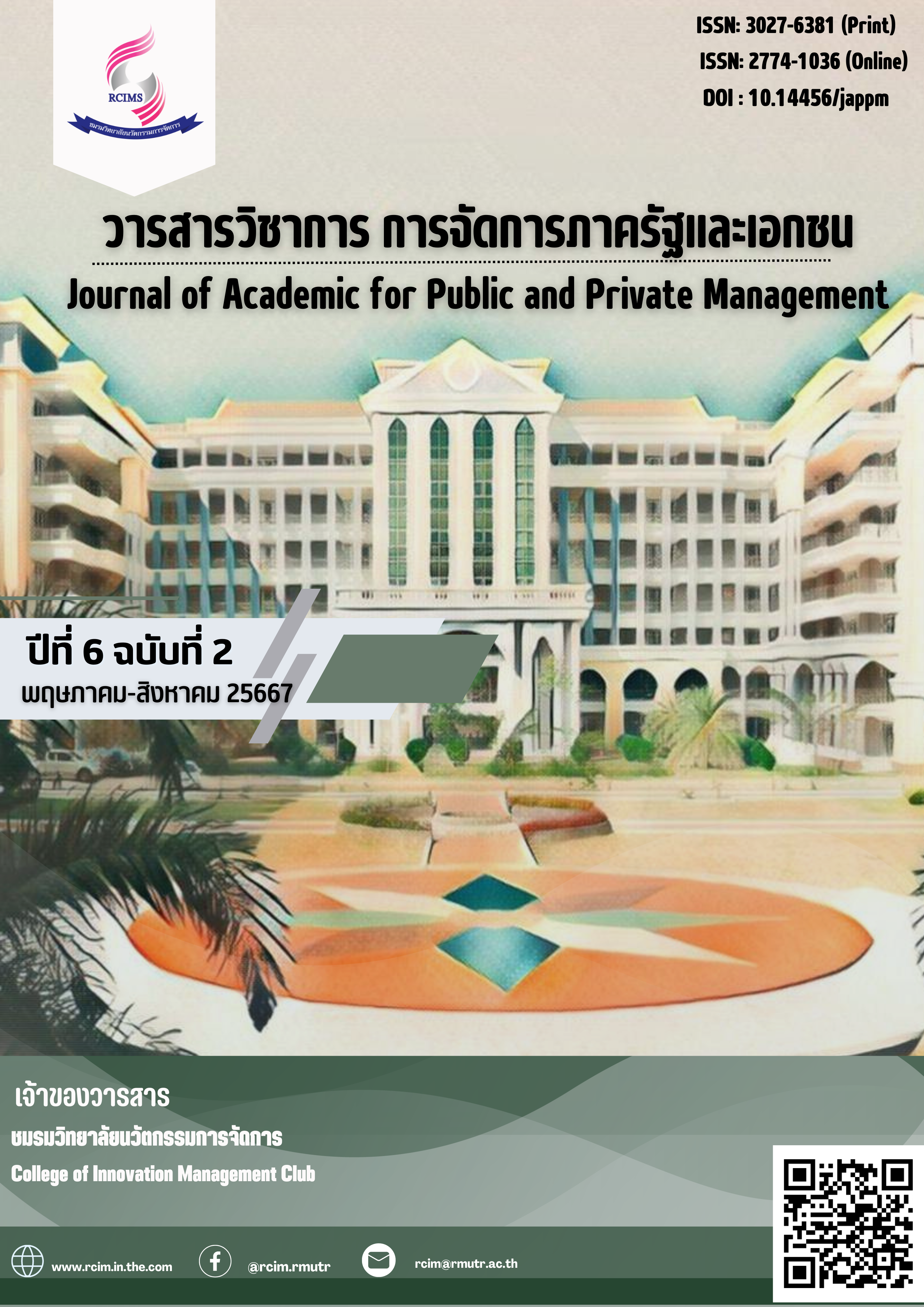การธำรงรักษาบุคลากรในมหาวิทยาลัยของรัฐในเขตปริมณฑลกรุงเทพมหานคร ในมุมมองทางวัฒนธรรมองค์กร
Main Article Content
บทคัดย่อ
บทความนี้มีวัตถุประสงค์1)เพื่อพรรณนาสภาวะปัจจุบันของการธำรงรักษาบุคลากรในมหาวิทยาลัยของรัฐ2.)เพื่อระบุเงื่อนไขและอุปสรรคในการธำรงรักษาบุคลากรในมหาวิทยาลัยของรัฐ3.)เพื่อเสนอแนะแนวทางในการปรับปรุงและพัฒนากระบวนการการธำรงรักษาบุคลากรในมหาวิทยาลัยของรัฐ เป็นการวิจัยเชิงคุณภาพ ผู้ให้ข้อมูลสำคัญ คือ กลุ่มผู้บริหาร กลุ่มวิชาการ กลุ่มสนับสนุน จำนวน 14 คน ใช้แบบสัมภาษณ์เป็นเครื่องมือการวิจัย วิเคราะห์ข้อมูลโดยใช้หลักการวิเคราะห์แก่นสาระ ผลการวิจัยพบว่า1) สภาวะปัจจุบันของการธำรงรักษาบุคลากรพบว่าองค์กรมีความเชื่อมั่นในตัวบุคลากร มีการสร้างปฏิสัมพันธ์ผ่านกิจกรรม บุคลากรมีความพึงพอใจในงาน ที่ ความผูกพันบุคลากรมีความรู้สึกเชิงบวก ความไม่ผูกพันเป็นความผูกพันในงาน มีการรับรู้ถึงการสนับสนุนขององค์กร การจัดการทรัพยากรมนุษย์ขาดการวางแผนเชิงกลยุทธ์ มีการสนับสนุนบุคลากรตามบทบาทหน้าที่ วัฒนธรรมองค์กร ความเป็นพี่เป็นน้อง การช่วยเหลือ การจบจากสถาบันเดียวกัน การธำรงรักษาบุคลากร ให้ค่าตอบแทนสวัสดิการ ความก้าวหน้าในการทำงาน การสื่อสาร สภาพแวดล้อม2.)เงื่อนไขและอุปสรรคในการธำรงรักษาบุคลากรพบว่าองค์กรขาดการบริหารความสัมพันธ์ ขาดความพึงพอใจในงาน ขาดการสร้างความผูกพัน กฎระเบียบที่ติดขัด ไม่มีการวางแผนเชิงกลยุทธ์ในด้านการจัดการทรัพยากรมนุษย์ วัฒนธรรมองค์กรที่กดดัน กลั่นแกล้ง เอาชนะ แข่งขัน เอื้อประโยชน์ให้พวกพ้อง ไม่ชอบการเปลี่ยนแปลง คิดแง่ลบ3.) แนวทางในการปรับปรุงและพัฒนาการการธำรงรักษาบุคลากรพบว่าพัฒนาการสื่อสาร มีส่วนร่วม มอบหมายงานสำคัญ เป็นกันเอง ผลตอบแทนที่ดี การทำกิจกรรม ความยืดหยุ่น รับฟังความคิดเห็น ความใส่ใจในบุคลากรและครอบครัว ความเป็นพี่เป็นน้อง ความยุติธรรม ลักษณะงานที่เหมาะสม การครองใจคน
Article Details

This work is licensed under a Creative Commons Attribution-NonCommercial-NoDerivatives 4.0 International License.
References
Adeoye, A., O. & Hope, O. (2020). Organizational Culture, Employee Retention and Employee Loyalty: Empirical Evidence from Nigeria. Academic Journal of Economic Studies, 6(3): 139–145.
Almutairi, Y., M. & Alenezi, A., K. (2020). The impact of organization culture and environment on leadership effectiveness applied study on some governmental organizations in the state of Kuwait. Journal of Public Affairs, 21(4). doi.org/10.1002/pa.2198.
Anitha, J. & Begum, F., N. (2016). Role of Organizational Culture and Employee Commitment in Employee Retention. International Journal of Asian School of Business Management, 9(1). 17-28.
Armstrong, M. & Taylor, S. (2014). Armstrong’s Handbook of Human Resource Management
Practice (13th ed). Philadelphia. Kogan Page Limited.
Armstrong, M. (2006). A handbook of Human Resource Management Practice. London and Philadelphia. Kogan Page Limited.
Armstrong, M. (2020). A handbook of human resource management practice (10th ed.). Philadelphia. Kogan Page Limited.
Azmi, F. T. (2019). Strategic Human Resource Management Text and Case. United Kingdom. Cambridge University Printing House.
Beardwell, J. & Thompson, A. (2017). Human Resource Management A Contemporary Approach (8th ed.). United Kingdom. Pearson Education Limited.
Buchanan, D., A. & Huczynski, A., A. (2019) Organization Behavior (10th ed.). United Kingdom. Pearson Education Limited.
Colquitt, J., A., LePine, J., A. & Wesson, M., J. (2019). Organization Behavior Improving Performance and Commitment in the Workplace (6th ed.). New York. McGraw-Hill.
Cross, R., Rollag, K., Opie, T. & Pryor, G. (2017). Connect and Adapt: How Network Development and Transformation Improve Retention and Engagement In Employees’ First Five Years. Organization Dynamics, 47(2): 115-123.
Das, B., L. & Baruah, M. (2013). Employee Retention: A Review of Literature. Journal of Business and Management, 14(2): 8-16.
Eisenberg, E., M., & Riley, P. (2001). The new handbook of organizational communication: Advances in theory, research, and methods Thousand Oaks, CA: Sage.
Inabinett, J., M. & Ballaro, J., M. (2014). Developing an Organization by Predicting Employee Retention by Matching Corporate Culture with Employee’s Values: A Correlation Study. Organization Development Journal, 32(1): 55-74.
Jeong, Y. & Kim, M. (2021). Effects of perceived organizational support and perceived organizational politics on organizational performance: Mediating role of differential treatment. Asia Pacific Management Review, 27(3), 190-199.
Lee, T., W., Hom, P., Eberly, M., & Li, J. (2017). Managing employee retention and turnover with 21st century ideas. Organizational Dynamics, 31(3), 237-256.
Loutier, O., Felusiak, L., Hill, C. & Pemberton-Jones, E., J. (2015). The Importance of Developing Strategies for Employee Retention. Journal of Leadership, Accountability and Ethics, 12(2): 119-129.
Lussier, R., N. & Hendon, J., R. (2019). Human Resource Management (3rd ed.). California. SAGE Publications.
McShane, S. L. & Von Glinow, M. A. (2018). Organizational behavior emerging knowledge global reality (8th ed.). New York. McGraw-Hill Education.
Miller, K. (2012). Organization communication (6th ed). Cengage Learning.
Noe, R., A., Hollenbeck, J., R., Gerhart, B. & Wright, P., M. (2016). fundamentals of Human Resource Management (6th ed.). New York. McGraw-Hill Education.
Parmenter, J., & Barnes, R. (2021). Factors supporting Indigenous employee retention in the Australian mining industry: A case study of the Pilbara region. The Extractives Industries and Society, 8, 423-433.
Pittino, D., Visintin, F., Lenger, T., & Sternad, D. (2016). Are High Performance Work Practices Really Necessary in Family SMEs? An Analysis of the Impact on Employee Retention. Journal of Family Business Strategy, 7: 75-89.
Rhoades, L. & Eisenberger, R. (2012). Perceived Organizational Support: A Review of the Literature. Journal of Applied Psychology, 87(4), 698-714.
Robbins, S., P. & Judge, T., A. (2016). Essentials of Organizational Behavior (15th ed.). New Jersey. Pearson Education Limited.
Robbins, S., P. (2005). Organization Behavior. New Jersey. Pearson Education.
Sinding, K. & Waldstrom, C. (2014). Organization Behavior (5th ed.). London. McGraw-Hill Education.
Singh, D. (2019). A Literature Review on Employee Retention with Focus on Recent Trends. IJSRST, 6(1), 425-431.

